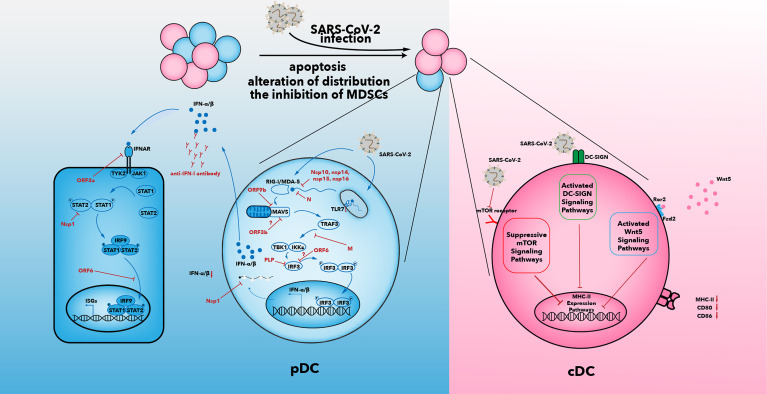Figure 2.
Multiple suppressive mechanisms in SARS-CoV-2-infected DCs from patients with severe COVID-19. The number of DCs in patients decreases after SARS-CoV-2 infection. Increased apoptosis, alterations in distribution of DCs, and inhibition of MDSCs may be associated with a decrease in DC number. IFN-I secretion is inhibited by various viral proteins that have been shown to be effective against IFN-I signaling in SARS-CoV infection (104). In addition to the effects of viral proteins, anti-IFN antibody and reduced expression of TLR7 have been observed in some patients with severe COVID-19. The capability of antigen presentation is impaired in cDC1 and cDC2. Inhibition of the mTOR signaling pathway, activated DC-SIGN pathway, and activated Wnt5 pathway could contribute to downregulation of MHC-II and co-stimulatory molecules. IFN, interferon; IFNAR, interferon alpha and beta receptor; mTOR, mammalian target of rapamycin; IκB, inhibitor of nuclear factor κB; IRF, IFN regulatory factor; ISG, IFN-stimulated gene; JAK, Janus kinase; IKKϵ, IκB kinase-ϵ; M, membrane; MAVs, mitochondrial antiviral signaling proteins; N, nucleocapsid; Nsp, non-structural protein; ORF, open reading frame; P, phosphate; DC-SIGN, dendritic cell-specific intercellular adhesion molecule 3-grabbing non-integrin; PLP, papain-like protease; RIG-I, retinoic acid-inducible gene-I; MDA5, melanoma differentiation-associated gene 5; SARS-CoV-2, severe acute respiratory syndrome-coronavirus 2; TANK, TRAF family member-associated NF-κB activator; TBK1, TANK-binding kinase 1; TRAF3, tumor necrosis factor receptor-associated factor 3; STAT, signal transducer and activator of transcription; TYK2, tyrosine kinase 2; Wnt5, Wnt oncogene analog 5.

